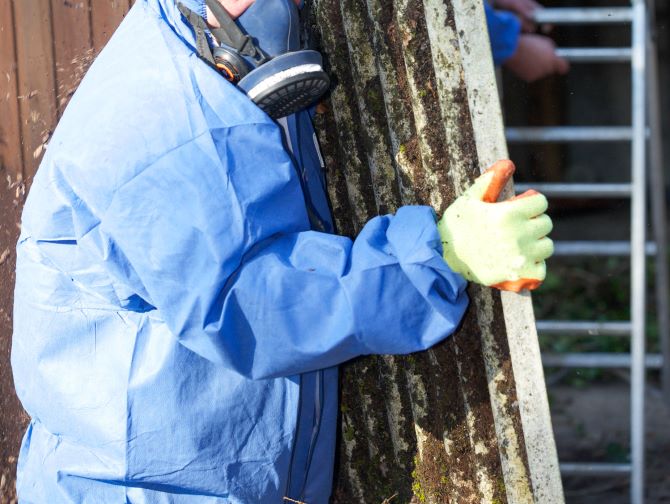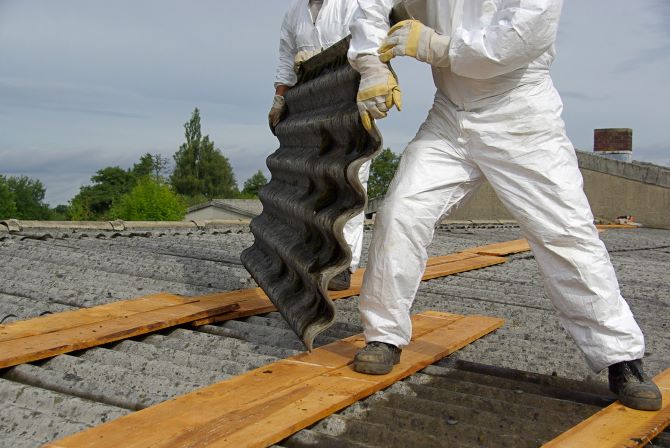If your house was built before 1 January 1994, the chances of asbestos being present are quite high. When you remodel or demolish, the asbestos is released, which is very harmful to your health. Do you think you have asbestos in your home and want it removed as an individual? Read all about asbestos removal for individuals in this article.
What does asbestos removal cost for individuals?
The cost of asbestos removal depends on several factors:
- The amount of asbestos that needs to be removed;
- Circumstances that make removal more difficult, such as when the asbestos is difficult to reach;
- Size of the room;
- Type of asbestos inventory.
See the table below for the average prices for asbestos removal as an individual:
| Project | Costs, incl. VAT |
|---|---|
| Asbestos inventory (for residential property) | |
| – Inventory of visible material | £ 300 – £ 500 |
| – Full inventory | from £ 450 |
| Asbestos removal | |
| – Corrugated sheets 1 – 10 m2 | £ 600 – £ 800 |
| – Corrugated sheets 11 – 20 m2 | £ 700 – £ 900 |
| – Corrugated sheets 21 – 30 m2 | £ 800 – £ 1.000 |
| – Corrugated sheets 31 – 50 m2 | £ 900 – £ 1.100 |
| – 1 room up to 35 m2 | £ 900 – £ 1,100 |
| – 2 rooms up to 40 m2 | £ 1,100 – £ 1,300 |
| – 3 rooms up to 50 m2 | £ 1,300 – £ 1.500 |
| – 2 spaces up to 70 m2 | £ 1,600 – £ 1,800 |
| Precessing asbestos-containing material | |
| – Packaging for asbestos-containing material | £ 0 – £ 30 (suitable for 1.500 kg) |
| – Dumping asbestos-containing material | £ 0 – £ 25 per 100 kg |
Find the best specialist for your project and get free quotes.
Start

What do you need to think about when removing asbestos as a private person?
When removing asbestos, there are many things you need to consider as a private person. Therefore, follow the step-by-step plan below to make sure you do not forget anything.
Step 1: Asbestos inventory
Would you, as a private person, like to convert or demolish a building and was built before 1 January 1994? If so, it is mandatory to have an asbestos inventory carried out. Asbestos inventories should only be carried out by certified companies.
Step 2: Asbestos inventory report
The findings of the asbestos inventory are recorded in the asbestos inventory report. This states whether or not asbestos is present in your home, in what quantities and with what risks. It also provides recommendations for follow-up steps and an estimate of the cost of asbestos removal. You will need this report to apply for permits, for example, or to start demolition.
Stage 3: Demolition notification
Is there indeed asbestos in the building? If so, a demolition notification must be made before removal. By this notification, the government understands both the demolition of a building and part of it. So a demolition notification may also be required for renovations.
You can submit a demolition notification via the Environment Counter or to your municipality, but usually the asbestos company will do this for you. Are you unsure whether a demolition notification is compulsory for you? The professional or your municipality can help you with this.
Step 4: Asbestos removal
After the municipality has approved your demolition application, the asbestos specialist will start removing the asbestos. There are different methods for removing asbestos, you will find them further on in this article.
How does asbestos removal work for individuals?
There are different methods for removing asbestos. Some methods are more controlled than others, making it less likely that asbestos fibres will be released. The asbestos specialist uses one of the following methods to remove the asbestos:
- Containment method
- Couveuse methose
- Open air method
Containment method
This is the safest method to remove asbestos, but can only be used indoors. Asbestos roofs or walls can therefore not be removed with this. The specialist uses foil to build a space around the asbestos source. Within this space, special equipment, including air cleaners and asbestos hoovers, are used to apply negative pressure to the asbestos. This releases the asbestos fibres and allows them to be filtered away.
Couve or glove bag method
In the incubator method, the asbestos specialist works with an incubator bag, which the specialist uses to seal the space around the asbestos source. The asbestos can be released into the bag without danger, as the fibres remain in it. The specialist then enters the room to clean the asbestos source with a special hoover.
By wearing a special suit, the asbestos specialist protects himself from the released asbestos. All the waste and released fibres are collected in the bag. This method is used when removing ceilings or vent pipes, among other things.
Open air method
This method is done only for asbestos located outside. On the roof of a shed or garage, for example. Because asbestos removal takes place outdoors, this method is the least manageable. The asbestos-containing material is removed as whole as possible and is then safely packed and disposed of.

Asbestos removal: do it yourself or outsource?
The basic principle of asbestos removal is: don’t do it yourself. The regulations surrounding asbestos are very strict to protect both people and the environment. In fact, there are major health risks involved. Therefore, leave asbestos removal to a specialist.
Under strict conditions, you are allowed to remove certain asbestos-containing items yourself, although this is not recommended. This is because incorrect removal is more dangerous than leaving it in place. Think, for example, of boards that are screwed down or loose floor tiles. Note: never remove things yourself that need to be wrenched or pulled loose.
Conditions for self-removal are:
- The total area is less than 35 m2.
- The whole surface must be removed in one go.
- The material is not damaged and the asbestos is bonded.
- You do not have to pull, pry or break to loosen the material.
- You remove the material in its entirety. You may also not break or saw anything into smaller pieces afterwards for easy transportation.
- You will make a demolition notification beforehand. You may only remove with permission from the municipality.
Removing an asbestos roof may not itself if:
- your roof is larger than 35 m2;
- there are roofing pipes on the roof;
- it is dangerous to remove the roof because you have to demolish part of it, for example;
- you cannot or do not want to abide by the municipal conditions;
- it is a commercial building or business equipment.
For more information, visit the InfoMil Knowledge Centre website. When in doubt, always call in an asbestos removal company. They have the right tools and knowledge to remove asbestos safely.
Find the best specialist for your project and get free quotes.
Start
Frequently Asked Questions
When selling your house, you do not have to remove asbestos, as long as the asbestos does not pose a danger to people and the environment. Are you going to buy a house and the seller does not know whether the house contains asbestos? If so, have an asbestos inventory carried out by a certified company. The costs of the inventory and removal of the asbestos will be determined between you.
No, if the asbestos poses no immediate health risk, you may leave it in place. Instead, draw up an asbestos management plan. This plan tells you how the building can be used safely now and in the future.